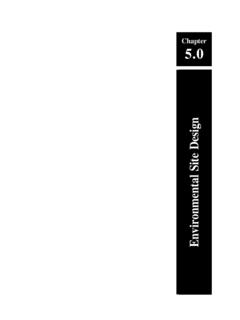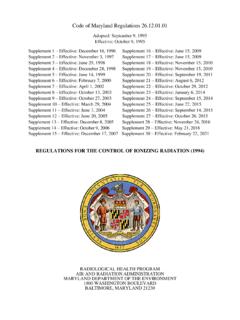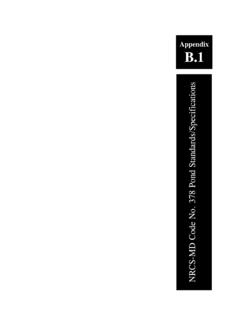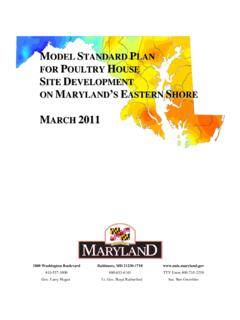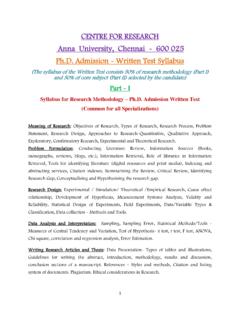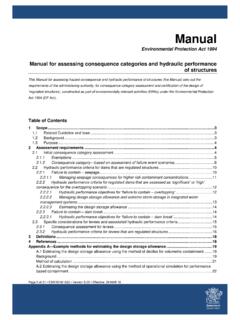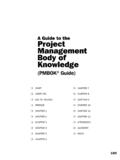Transcription of Wastewater Design Guidelines - 2016 - Maryland
1 1 Design Guidelines FOR Wastewater FACILITIES Maryland DEPARTMENT OF THE ENVIRONMENT ENGINEERING AND CAPITAL PROJECTS PROGRAM 2016 Purpose: Recommended Standards for Wastewater Facilities (as revised) for Great Lakes-Upper Mississippi River Board of State and Provincial Public Health and Environmental Managers (10-State Standards) will continue to be the main source of guidance for the program s Design review and construction permit functions. The 10-State Standards can be downloaded free from website, or purchased as a book from the Health Education Services (HES) at These Guidelines are intended to serve as addenda to supplement the 10-State Standards.
2 The 10-State Standards (as revised) and these Guidelines supersede all other Design Guidelines for Wastewater (sewerage facilities) previously issued by MDE. At the appearance of conflicting information, these Guidelines supersede the 10-State Standards as they intended to provide further clarifications specific to MDE. Additional requirements beyond these Guidelines and the 10-State Standards can be added by the facility s discharge permit and/or consent order or decree issued by MDE. If a local jurisdiction has more stringent requirements for any specific item, the more stringent requirements must be used for that item.
3 2 ADDENDUM TO CHAPTER 10 ENGINEERING REPORTS AND FACILITY PLANS HYDRAULIC CAPACITY Terminology and Typical Use: Term Description Typical Design Use Average Daily Flow (Current or Initial) For existing facility, it s the current average daily flow based on the last three years data. This is done by averaging the daily flow for each year, then averaging the three years. For a proposed facility, it s the project initial flow. To evaluate and address low flow conditions (minimum flows) Design Average Flow ( Design Capacity) Average daily flow a facility is designed to successfully process To develop maximum flowrates and peaking factors to be used for the Design of equipment and unit processes.
4 Approved/Permitted Design Capacity A treatment plant Design flow approved by the County Water and Sewer Plans and permitted by the discharge permit with certain limits and conditions. It must be greater than or equal to a proposed Design flow. The maximum flow that can be evaluated to become the facility s new Design capacity. Diurnal Flow Pattern The typical daily flow pattern for domestic Wastewater with usually peaks occurring in the morning and evening. Important in developing process control strategies for managing high flows.
5 Peak Hourly Flow The largest volume of flow occurring within 1-hour period in the record examined. Sizing of pumping facilities and conduits, sizing physical treatment units (ie grit chambers, screens, sedimentation tanks, filter hydraulic capacity). Sizing chlorine or other disinfection contact tanks. Also important in developing process control strategies for managing high flows. Maximum or Peak Daily Flow The largest volume of flow occurring within a 1-day period in the record examined. Sizing of equalization tanks Sizing of sludge pumping system Sizing of chemical feed system Maximum Monthly Flow The average daily flows for the month with the highest total flow in the record examined.
6 Sizing of the bioreactor Sizing of the chemical storage tank Sizing of denitrification filter 3 Peaking Factor: The peaking factor is used to forecast the maximum/peaking flows for the new proposed Design capacity. The above average and maximum/peak flows are highly impacted by inflow/infiltration (I/I) and wet weather events. Therefore, the preferred method of estimating these values is by using actual data, which can account for any excessive I/I in the system and yield higher peaking factors than those of a typical system.
7 When available, a record of three or more consecutive calendar years should be examined at an existing facility. Peaking factors should be calculated independently for each full consecutive calendar year examined, and then the highest of each type (hourly, daily, monthly) is selected. Peaking Factor (PF) = peak flow for the calendar year (hourly, daily, monthly) average daily flow for the calendar year The following typical peaking factors (PF) should be used if there is not sufficient historical data available.
8 Design Capacity Range Hourly PF Daily PF Monthly PF 0 to MGD 4 3 2 to 16 MGD ( X Design Capacity5/6) Design Capacity 75% of Hourly PF 50% of Hourly PF, but not below More than 16 MGD 2 Peak Flow = PF calculated above X Proposed Design Capacity Proposed Design Capacity: Proposed Design Capacity = Current Average Daily Flow (0 for new facilities) + Projected Future Flow Projected Future Flow: Future flows are projected based on 100 gallons per day per person, or 250 gallons per day per Equivalent Dwelling Unit (EDU).
9 In addition, the following are the flow projections for different establishments: 4 Table I - Flow Projection Based Upon Gallons Per Person Per Day Airports (per passenger) ..5 Apartments-multiple family (per resident) ..60 Bathhouses and swimming Camps: Campground with central comfort With flush toilets, no showers ..25 Day camps (no meals served) ..15 Resort camps (night and day) with limited plumbing ..50 Luxury camps ..100 Cottages and small dwellings with seasonal Country clubs (per resident member).
10 100 Country clubs (per non-resident member present)..25 Dwellings: Boarding additional for non-resident Luxury residences and estates ..150 Multiple family dwellings (apartments)..60 Rooming Single family Factories (gallons per person, per shift, exclusive of industrial wastes) ..35 Hospitals (per bed space) ..350 Hotels with private baths (2 persons per room)..60 Hotels without private Institutions other than hospitals (per bed space)..125 Laundries, self-service (gallons per wash, , per customer).




